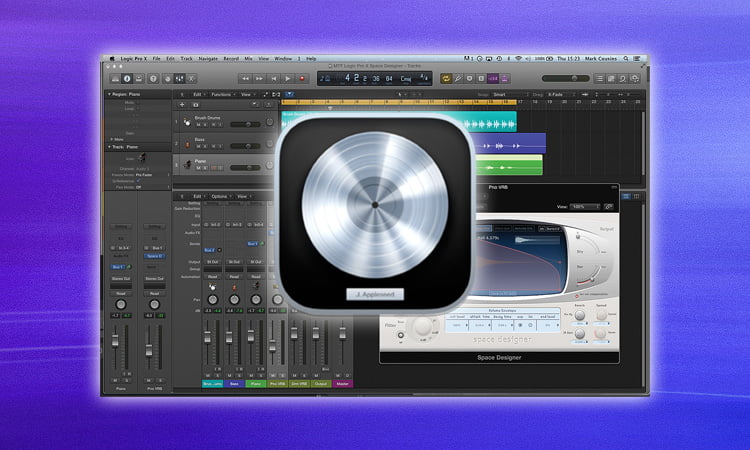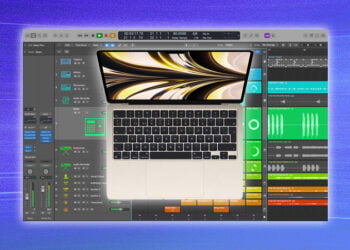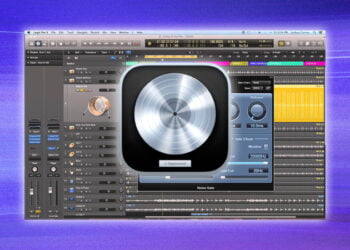Today’s music production technology enables anyone to produce high quality audio recordings from the comfort of their own home.
Logic Pro X is at the forefront of this technology, offering an extensive array of features and plugins.
One of these plugins is Reverb, which adds an echo-like effect to audio recordings.
Reverb is a powerful tool that can be used to create a wide range of sounds, from reflective and ambient to dense and huge.
In this blog post, we’ll be taking a look at how to add reverb in Logic Pro X.
We’ll examine the types of reverb available, how to set up the plugin and how to tweak parameters to get the sound you’re looking for.
With this guide, you’ll be able to easily add reverb to your audio recordings and create unique and professional-sounding mixes.
Create a new Software Instrument track
To add reverb in Logic Pro X, the first step is to create a new Software Instrument track.
This can be done by clicking the “+” button located at the top of the Tracks Area, or by pressing Command+N on your keyboard.
This will bring up a pop-up window, where you can select the type of track you want to create, select “Software Instrument,” and then select “Reverb” from the menu.
Once the track is created, apply a reverb plug-in to it by dragging and dropping the desired reverb plug-in from the Library.
You can then adjust the parameters of the plug-in to get the desired sound.
Open the Library tab
To begin, open Logic Pro X and select the Library tab in the upper right corner.
This will display all of the available audio loops and samples, separated by their category.
You can also use the search bar at the top of the Library tab to find a specific sound you’re looking for.
Once you’ve located your desired audio loop or sample, drag and drop it into one of the tracks in the Arrange window.
Then you can adjust the length of the loop to fit your project’s timeline.
Select the Reverb effect
To select the Reverb effect in Logic Pro X, open the Audio FX window and select the Reverb button.
This will open up the Reverb effect window, where you can choose from a variety of Reverb types.
Reverb is an effect used to add depth and space to a sound, so you may want to experiment with different settings to get the desired effect.
When you’re happy with your Reverb selection, click the “OK” button to confirm your selection.
Now that you’ve chosen the Reverb effect, you can adjust the parameters to fine-tune the sound and achieve the desired effect.
Set the Dry/Wet mix
The fourth step to adding reverb in Logic Pro X is setting the dry/wet mix.
This is the balance of the original sound, or the ‘dry’ sound, and the processed sound, or the ‘wet’ sound.
You can adjust this mix using the ‘Mix’ knob in the bottom right corner of the reverb plugin.
Setting the mix too high will make the reverb sound overpowering, so it’s best to start at a low mix and gradually increase it until you’re happy with the sound.
You can also use the ‘Dry’ and ‘Wet’ knobs to adjust the volume of each sound independently, allowing for even more control over the reverb sound.
Adjust the Decay
After you’ve adjusted the pre-delay and tone, the next step is to adjust the decay.
This will determine how long the reverberated sound will last.
To adjust the decay, simply turn the knob to the right to increase the length of the reverberated sound.
This will also increase the intensity of the reverb.
If you turn the knob to the left, you will reduce the length and intensity of the reverb.
Experiment with these settings until you’re happy with the result.
Add Pre-delay
Once you’ve set up your reverb, you can start to tweak its sound.
The sixth step is to add pre-delay.
Pre-delay is the amount of time the reverb will pause before it starts to echo.
This can be adjusted in milliseconds, and it can give your reverb a more natural sound.
If the pre-delay is set too low, you’ll get a “slapback” effect, which is great for shorter sounds, like snare drums.
If it’s set too high, you’ll get a more diffuse reverb that can last for a few seconds.
Pre-delay is especially useful for making your reverb sound more realistic and natural.
Change the Color
You can adjust the color of the reverb effect for visual purposes.
To do this, simply click the color swatch located in the same panel as the reverb settings.
A color picker will appear, allowing you to select a custom color or choose one of the preset colors.
This can be a great way to make the reverb effect stand out in the mix, or to make sure it blends in seamlessly with the rest of the music.
Add Modulation for a more dramatic effect
Once you’ve added reverb to your track, you can add modulation for a more dramatic effect.
Modulation is a process of changing the characteristics of a sound over time.
You can create a variety of effects with modulation, including tremolo, chorus, vibrato, and flanging.
To add modulation in Logic Pro X, go to the “Inspector” tab, click the “Modulation” button, and adjust the depth and rate of modulation.
Experiment with different settings to achieve the desired effect.
Conclusion
In conclusion, using reverb in Logic Pro X is a great way to add depth and life to your recordings.
Whether you are using the built-in reverb plugins or an external reverb plugin, Logic Pro X makes it easy to add reverb to your tracks.
With a few simple steps, you can add reverb to your tracks and create an even more full and immersive sound.






















